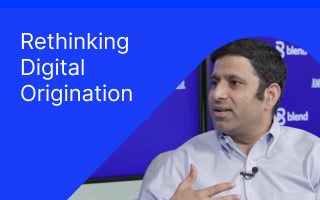April 14, 2022 in Challenges and solutions
4 examples of excellent customer service in banking
Pioneering banks are achieving success with digital tools that facilitate better experiences for consumers.

Today’s consumers expect excellent service from their bank. In fact, they rank it above low fees, product availability, and security features.
Calling all pioneers: insights made just for you
Subscribe for industry trends, product updates, and much more.
But what makes some customer service experiences shine a little brighter and stand apart from the rest? The magic usually happens when staff can deliver what the customer actually wants, when they really need it.
Pioneers in financial services are analyzing changing trends about how, when, and where today’s consumers want to bank. Technology is rapidly changing the way we work, communicate, and — of course — bank. Those who are steering the ship understand the importance of not only meeting consumers where they are today, but also planning ahead to proactively address new needs in the future. These financial service leaders are freeing up members of the team to deliver higher levels of service and tailor offers to make banking more personal.
Some examples of how you can improve customer service in banking include:
- Delivering effective omnichannel experiences
- Using automation to improve efficiency
- Making banking more personal
- Adapting and responding to new needs
Let’s dive further into these examples and take a closer look at what they can look like in practice.
Delivering effective omnichannel experiences
In today’s highly digital environment, it’s easy to assume that digital-only banking is the way to go. However, today’s consumers want access to both digital and in-person touchpoints and expect the same level of service and polish from each.
Effective omnichannel banking enables consumers to get the type of service that they are looking for — whether that’s self-serve or in person — through their preferred channel and at a time that suits them. It also enables banking support staff to get a single view of all customer interactions and progress. As a result, they can answer questions more effectively and efficiently.
Example: How Navy Federal Credit Union is delivering anytime, anywhere banking
Virginia-based Navy Federal Credit Union exclusively serves the military, veterans, and their families — a segment to which it promises “once a member, always a member.”
Great customer service is important in delivering on this promise, so to build on that, Navy Federal Union partnered with Blend.
“As a lender, it’s really important for us to be consistent in the member service experience, so Blend has provided flexibility to our members,” explained Prabha KC, a mortgage loan officer at the company. “If the members are overseas they can still access their loan information.”
Offering self-service channels was one way the company sought to improve its service delivery, not only facilitating 24/7 support but also freeing up its member service representatives to do more added value work on behalf of their members.
As a result of the implementation, the number of self-service applications doubled and the time taken to submit an application decreased by 40%.
Using automation to free up quality time that can be spent on the customer
Banking is traditionally a time- and labor-intensive business with many manual steps and paper-based processes that can inhibit good customer service. Delays can happen regularly. In fact, on average it can take anywhere between 30-60 days to close on a mortgage.
Automation can help with this, allowing banking teams to more efficiently manage the key tasks they need to carry out for customers.
For example, automation can improve service for a new applicant in several ways. Not only does it streamline the application process and overall journey thanks to automated data capture, validation, and pre-approvals, but it can also reduce the paper burden from banking teams, freeing up their time to focus on delivering added value to customers.
Automated follow ups, meanwhile, can help ensure banking teams never miss a check in — and can help consumers satisfy conditions with fewer interactions.
Returning customers also benefit from better service through automation. Information they have already provided in previous applications can not only be used to pre-fill new applications, but also for pre-approvals for products that meet their ever-evolving needs.
Example: Putting automation into practice at Elements Financial
The team at Indianapolis-based credit union Elements Financial wanted to stay ahead of consumer expectations. Using the Blend platform to automate letters of explanation and connect assets — just a couple of ways in which Blend’s automation features can help to drive efficiency — the company has achieved its mission. Instead of applications taking three weeks, they now take 15-20 minutes. What’s more, they have shaved up to two hours off the time spent processing each loan because of automated follow-ups.
Lending Risk Manager Jamie Bonner explained the difference: “Prior to Blend I would email a member and say, ‘Hey, I still need this pay stub or an asset statement. I cannot send it over to processing until I have all of these things, and it will delay your time to close.’ Now all of that information is in the file right after they apply, and there is no delay.”
This streamlined process may be a contributing factor in the growth Elements Financial has experienced since leveraging Blend’s platform. The number of approved applications for products including deposit accounts and vehicle loans have increased by an average of 11%.
Making banking more personal
Despite the fact that more customers carry out their banking activities online than they did even two years ago, they still value human engagement — and have high expectations when it comes to service delivery.
By investing in personalization, banks can deliver the white glove service that customers are looking for. In fact, the majority (72%) of customers say that personalization is highly important in financial services today.
Banking leaders achieve success by listening carefully to what customers have told them and delivering product offers, recommendations, and rates aligned with that information. To help in that delivery, they can adopt tools that apply artificial intelligence and process automation to make personalized offers at exactly the right moment.
Example: How BOK Financial is personifying success
Oklahoma-based BOK Financial turned to Blend to help it meet consumer demand for an intuitive and personalized banking experience.
By running consumer loans and mortgage applications through Blend, the company is delivering a tailored experience and, as a result, has seen completion rates more than triple. Moreover, the majority of volume now comes through digital channels — in stark contrast to the previous 15%.
Adapting and responding to new needs
When banking teams prioritize their customers’ needs and preferences, they can deliver better service, and they can achieve more impactful customer relationships as a result.
One way of doing this is by staying on top of new trends and expectations and adding appropriate functionality in a fast and effective way. Another involves understanding a customers’ financial journey and using the data customers have provided them with in a careful way to predict or react to significant life events and offer support when it is most needed.
The ability to quickly re-compose a product may be useful here. For example, a bank may discover that many of its customers have been impacted by a local storm. As a result, it could reposition one of its loans as a recovery product, and reach out with a personalized offer to those affected.
How Amarillo National Bank is growing and evolving with Blend
At the height of the pandemic, many lenders, including Texas-based Amarillo National Bank (ANB), searched for ways to continue closing loans remotely. The value of hybrid and electronic closing methods quickly became clear.
“We knew we had to move forward with the hybrid closings so that our customers didn’t have to go into the title companies to close their loans,” Debbie Bigelow, senior vice president, recalled
ANB’s team adopted Blend Close and has not looked back since. They will continue to adopt innovations that allow them to succeed in a rapidly changing operating environment.
How Blend is focused on helping you deliver excellent customer service
All of these success stories share something in common — each of the financial services companies involved has chosen to bolster their service delivery with our unified platform.
As a result, they have been able to have an incredible focus on the customer — something that is close to our hearts at Blend. In fact, we aim to bring a customer-first approach to everything we do.
As a comprehensive solution for financial services providers, the Blend platform provides:
- A consistent consumer experience, from application to close and beyond
- In-built automation, bolstered by integrations with leading data providers
- Back-end tools to improve customization of products while freeing staff to deliver personalized experiences
- Improved digital agility to respond to new needs faster

Ready to make these examples of exceptional customer service your reality?
Find out what we're up to!
Subscribe to get Blend news, customer stories, events, and industry insights.

